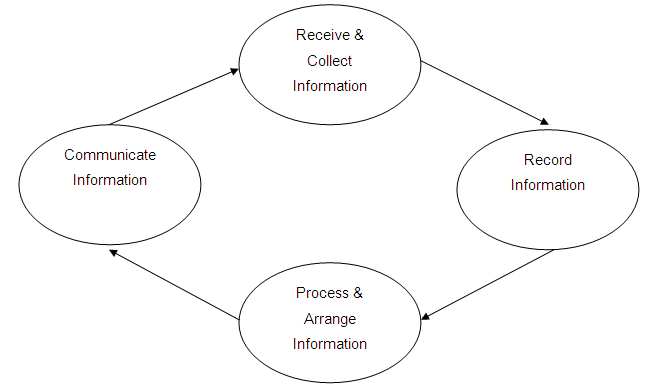The four functions of the administrative process can be presented as follows:

Receiving And Collecting Information
One of the major functions of the office is to receive and collect information relating to the activities of the organisation from various sources.
Information can be received from a variety of sources. This includes the following:
Internal sources: Such as the various departments, management and executives. It can take the form of letters, inter-department notes, circulars, reports, memoranda and emails.
External sources: Such as suppliers, customers, other organisations and Government departments. It can take the form of business letters, orders, invoices, inquiries, reports, circulars, telephonic messages, emails and so forth.
Sometimes the office itself has to send out inquiries, questionnaires and so forth, to collect information from various sources if it is found necessary for helping the management in taking decisions.
Another source of information is personal contact. Information is personal contact. Information may also be received from visitors coming to the office for meetings or conferences. Again, managers or departmental executives visiting other offices may also collect information.
Recording Information
After receiving and collecting information, the next major function of the office is to record the information in suitable form. The information received has to be converted into some form of written record.
The different forms in which records are maintained are:

Conversion of all information into written record not only facilitates its communication but also its preservation for future reference. The management, while formulating policy decisions, often have to consult information relating to past events and activities. It is, therefore, not only to record all information in a suitable form, but also to preserve it in such a way that it may be readily available and used at any time in the future. Records of information prepared by the office serve as a reference library for use by management.
Processing And Arranging Information
The information received and collected by the office from various sources is rarely in the form in which these may be readily used by management in the decision-making process. Information, facts and data collected have to be:
- Arranged
- Processed
- Organised
In a suitable form before these can be supplied to the management.
The information should be arranged in a readily usable form. The usual forms in which information is arranged are:
- Costing sheets
- Financial and statistical statements
- Charts and lists
- Reports and so forth
Communication Of Information
The office may be compared to a two-way pipeline for supplying information.
- The office must supply information and then it is processed by management.
- The office must communicate policy decisions, guidelines and instructions. Management issues these to departments for guidance.
- The information supplied to the management may be of a:
- Routine nature for example periodical returns on sales, stock position, staff attendance and so forth, or it may be of
- Special nature for example estimates of a special job, credit information regarding a particular client, and so forth.
The value of the information that is supplied to management depends on the promptness and accuracy with which it is done. Information, however, structured and complete, loses much of its value if it is:
- Not provided or is
- Not available in time or is
- Delayed in the process of communication